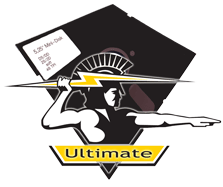 A new version of the firmware for the interface 1541 Ultimate is released. This version runs on both version of the Ultimate 1541 cartridge.
A new version of the firmware for the interface 1541 Ultimate is released. This version runs on both version of the Ultimate 1541 cartridge.
Version 2.4 includes the fixes that TLR made to the firmware, and adds the following features:
- CRT load (just by selecting the file, not on boot time)
- EasyFlash support (reading only, writing is not needed IMHO)
- Flashing and running custom FPGAs (Ultimate-II only), especially for those who want to do FPGA development without JTAG cable. FPGA bitfile will be flashed into the spare area of the Flash memory device, and the FPGA is booted from there. So there is no risk of bricking your device. (Flashing needs to be done for every boot still, optimizations will follow.)
For the rest, a lot of work has been done ‘under the hood’; especially in preparation of a native command interface to control the Ultimate from I/O space. But since this is not yet ready, it’s not included (=not enabled) in the 2.4 firmware.
Download:
source: 1541ultimate.net
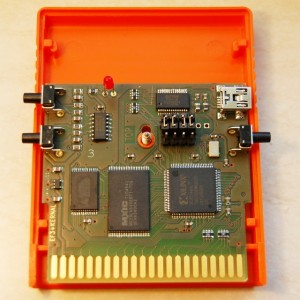 The cartridge EasyFlash III by Skoe is available on Retro-Donald shop. Like the previous version the VHDL code is open source.
The cartridge EasyFlash III by Skoe is available on Retro-Donald shop. Like the previous version the VHDL code is open source.
This version introduces several new features, like:
- Kernal emulation (no need hardware changes).
- If you choose to use the Kernal emulation the RAM will be available.
- You can choose 8 Kernal’s.
- You can choose 7 EasyFlash’s.
- USB connector for firmware updates.
- Emulation of FinalCartridge III, ActionReplay…
source: retro-donald.de skoe.de
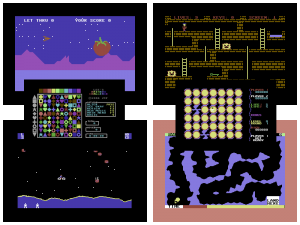 Some new cracked and trained games from your favorites groups TRIAD and Dinasours.
Some new cracked and trained games from your favorites groups TRIAD and Dinasours.
Download:
source: noname.c64.org/csdb
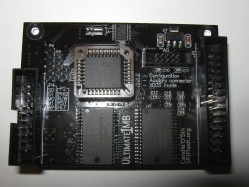
Autopsy:
After 8 long months of waiting i finally received the Ultimate 1Mb module by Candle’o'Sin.
The Ultimate 1Mb module is a expansion for Atari XE/XL.
This module allows a easy installation regardless of machine type one chooses and is not intrusive to original hardware. The Ultimate 1Mb was designed to fit in any XL/XE computer, including 1200XL and XEGS – there are no versions as such, the only diffrence might be with lenght of ribbon cables it connects to motherboard
Features:
- To be as much solderless as possible (only RW, PHI2, HALT and RESET lines need soldering)
- Fully flashable SpartaDOS-X with up to 320kbytes for its purposes
- RTC module for SDX with battery backup and NVRAM
- Fully flashable 4 OS ROM slots
- Hardware WRITE PROTECT for whole Flash array
- Configurable memory expansion with 4 modes of operation (disabled, 320k RAMBO, 578k COMPY SHOP, 1088k RAMBO)
- Customizable BASIC and MISSLE COMMAND slots (also flashable)
- System select/Memory exp mode select from integrated BIOS
source: spiflash.org atariage.com
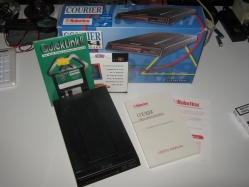
After many years, i’ve finally re-found in a box one of my USRobotics Courier HST Modem v34 upgraded to 33.6Kbps.
I used this modem for my BBS ‘Hidden Power’, before this version of USRobotics i had the first model that was much bigger and slower.
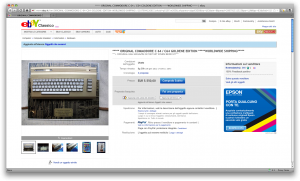 Commodore 64 Gold Edition on Ebay.
Commodore 64 Gold Edition on Ebay.
from Richard Lagendijk Homepage:
This a special edition of the Commodore C64, celebrating the 1.000.000th sale of the C64 in Germany. This is one of the most desirable Commodore items. There are about 300 golden Commodore C64 produced. The numbers from 1.000.000 until 1.000.100 were for the staff of the Commodore factory Braunschweig.
The rest was given to hard- en software companies, magazine-publishers and distributors. The C64 is a computer system with a keyboard, external power-supply and a motherboard. On the motherboard you will find a MOS 6510 processor, RAM / ROM memory, MOS 6569 VIC-II video chip, MOS 6581 SID sound chip and twice a MOS 6526 CIA. PAL version.
source: ebay.com richardlagendijk.nl
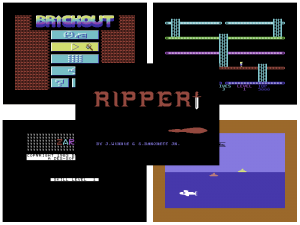 Some new cracked and trained games from your favorites groups Genesis Project, Onslaught and Dinasours.
Some new cracked and trained games from your favorites groups Genesis Project, Onslaught and Dinasours.
Download:
source: noname.c64.org/csdb
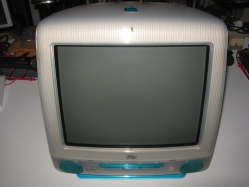
Autopsy:
from Wikipedia:
The iMac is a range of all-in-one Macintosh desktop computers built by Apple. It has been the primary part of Apple’s consumer desktop offerings since its introduction in 1998, and has evolved through five distinct forms.
The announcement of the iMac in 1998 was a source of discussion and anticipation among commentators, Mac fans, and detractors. Opinions were divided over Apple’s drastic changes to the Macintosh hardware. At the time, Apple was trying to improve its retail strategy. Apple declared that “the back of our computer looks better than the front of anyone else’s”.
Apple declared the ‘i’ in iMac to stand for “Internet”; it also represented the product’s focus as a personal device (‘i’ for “individual”). Attention was given to the out-of-box experience: the user needed to go through only two steps to set up and connect to the Internet. “There’s no step 3!” was the catch-phrase in a popular iMac commercial narrated by actor Jeff Goldblum.
Another commercial, dubbed “Simplicity Shootout”, pitted seven-year-old Johann Thomas and his border collie Brodie, with an iMac, against Adam Taggart, a Stanford University MBA student, with an HP Pavilion 8250, in a race to set up their computers. Johann and Brodie finished in 8 minutes and 15 seconds, whereas Adam was still working on it by the end of the commercial. Apple later adopted the ‘i’ prefix across its consumer hardware and software lines, such as the iPod, iBook, iPhone, iPad and various pieces of software such as the iLife suite and iWork and the company’s media player/store, iTunes.
source: wikipedia
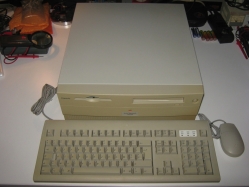
Autopsy:
from Wikipedia:
The Power Macintosh 4400 (also known as the Power Macintosh 7220 in some markets) was a mid-to-high-end Macintosh personal computer designed, manufactured and sold by Apple Computer from 1996 until 1998. The Power Macintosh 4400 was rather different from most other Macintosh models, in that the floppy disk drive is on the left rather than right, and like the Centris 650, the casing is made of metal rather than plastic. Apple did this to reduce production costs, and in addition also used more industry standard components.
It was also available in a PC compatible system with a 166 MHz DOS card containing 16 Mb of RAM. The first 4400 model was only sold to the Europe market, an updated 200 MHz 603e model was released in the United States in February 1997 as the Power Macintosh 4400.
The Power Macintosh 4400 is known as the Power Macintosh 7220 in Australia and Asia, where the number 4 is considered unlucky. The machine was always considered a bit of an oddball, and had a reputation as being one of Apple’s less well designed and performing machines.
source: wikipedia
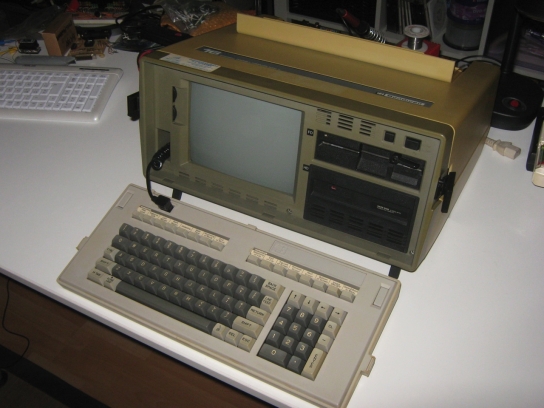
Autopsy:
from Wikipedia:
Bondwell was a US manufacturer of personal computers during the 1980s. In the early 1980s, Bondwell sold a line of Z80, CP/M-80 based Osborne-like luggables such as the models Bondwell-12, Bondwell-14 (1984) and Bondwell-16 (1985). An exceptional feature in these was an inbuilt speech synthesizer.
Their prices were exceptionally affordable for the time, although significant trade-offs were made in regard durability, for instance the chassis was rather flimsy plastic, falling far short of the ruggedness usually expected of luggables. The fanless power supply unit, located under the motherboard, often caused trouble. The choice of peripheral I/O devices made the use of interrupts virtually impossible.
The Bondwell-12 was a “luggable” portable computer with a built-in 9 inch (23 cm) monochrome CRT display, equipped with 64 kiB of internal memory, CP/M 2.2 and two single-sided, double density, 5.25 inch floppy disk drives (180 kiB). The Bondwell-14 had 128 kiB of memory, CP/M 3.0 and two double-sided drives (360 kiB). The Bondwell-16 had CP/M 3.0, one double-sided drive and a hard disk drive with a capacity of a bit less than 10 MiB.
The Bondwell-2 (1985) was a laptop computer with 64 kiB of memory, CP/M 2.2 and one single-sided, double density 3.5 inch floppy disk (360 kiB). 256 and 512 kiB memory extensions were available. It was one of the earliest laptops, as well as one of the few battery-powered CP/M computers.
source: wikipedia
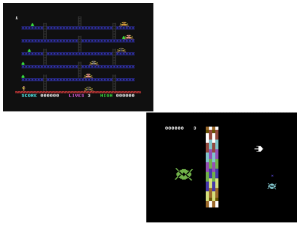 Some new cracked and trained games from your favorites groups Genesis Project and TRIAD.
Some new cracked and trained games from your favorites groups Genesis Project and TRIAD.
Download:
source: noname.c64.org/csdb
 Wishing you a Merry Christmas and Happy New Year.
Wishing you a Merry Christmas and Happy New Year.
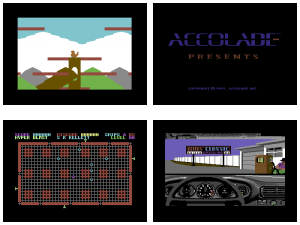 Some new cracked and trained games from your favorites groups Genesis Project, Nostalgia and AmiDog.
Some new cracked and trained games from your favorites groups Genesis Project, Nostalgia and AmiDog.
Download:
source: noname.c64.org/csdb
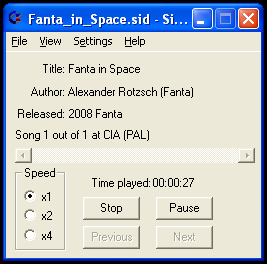 A new version of the program SidPlay for M$ Windows is released by Inge.
A new version of the program SidPlay for M$ Windows is released by Inge.
Download: SidPlay v2.6 (M$ Windows) (751)
source: noname.c64.org/csdb
 The High Voltage SID Collection (HVSC) is a freeware hobby project which organises Commodore 64 music (also known as SID music) into an archive for both musicians and fans alike.
The High Voltage SID Collection (HVSC) is a freeware hobby project which organises Commodore 64 music (also known as SID music) into an archive for both musicians and fans alike.
The work on the collection is done completely in the Team and contributors’ spare time and is proudly one of the largest and most accurate computer music collections known.
This update features (all approximates):
- 861 new SIDs (total: 41250)
- 156 fixed/better rips.
- 14 PlaySID/Sidplay1 specific SIDs eliminated.
- 11 repeats/bad rips eliminated.
- 786 SID credit fixes.
- 88 SID model/clock infos.
- 31 tunes from /DEMOS/UNKNOWN/ identified
- 12 tunes from /GAMES/ identified
- 51 tunes moved out of /DEMOS/ to their composers’ directories.
- 28 tunes moved out of /GAMES/ to their composers’ directories.
- 300 new STIL entries.
Download:
source: www.hvsc.c64.org
 A new version of the firmware for the interface 1541 Ultimate is released. This version runs on both version of the Ultimate 1541 cartridge.
A new version of the firmware for the interface 1541 Ultimate is released. This version runs on both version of the Ultimate 1541 cartridge. The cartridge EasyFlash III by Skoe is available on
The cartridge EasyFlash III by Skoe is available on 


















































 The High Voltage SID Collection (HVSC) is a freeware hobby project which organises Commodore 64 music (also known as SID music) into an archive for both musicians and fans alike.
The High Voltage SID Collection (HVSC) is a freeware hobby project which organises Commodore 64 music (also known as SID music) into an archive for both musicians and fans alike.


Recent Comments